In a digital world that has reshaped nearly every part of the service industry, the tip screen has quickly become a pivotal element in customer transactions. These screens—those often-appearing digital prompts that ask for a tip amount at checkout—are redefining tipping customs and sparking discussion on how tipping is integrated into our everyday spending. Once limited to service-heavy sectors like dining, the tipping prompt is now commonplace at coffee shops, delivery services, and even some retail outlets. With the rise of these digital prompts, the concept of tipping has changed considerably, bringing about new dynamics for customers and service providers alike.
In this article, we’ll explore how tip screens influence tipping behavior, what customers feel about them, and how businesses can optimize tip screens to enhance customer satisfaction and employee morale.
Introduction to Tip Screens and Their Impact on Tipping CultureThe evolution of tipping culture has accelerated significantly with the introduction of the tip screen—an ever-present digital prompt on point-of-sale systems that encourages customers to leave a gratuity. While tipping traditionally occurred in cash and often as an unspoken agreement between customer and server, tip screens have transformed the process into a visible and immediate request. Appearing on screens in coffee shops, bakeries, ride-shares, and more, these prompts have opened up discussions on everything from tipping norms to fair compensation for service workers.
How the Tip Screen Evolved in the Service Industry
Tip screens emerged from the rapid adoption of digital payment systems and an increasing preference for cashless transactions. Originally, these screens appeared on tablets in cafés and small retail spaces, but their use has spread across sectors as business owners noticed that digital tipping requests resulted in more frequent and larger tips. For customers, the tip screen not only makes tipping more convenient but also places a stronger social expectation on them to leave a gratuity, a shift that has impacted how both customers and employees view the tipping process.
The Technology Behind Tip Screens
Point-of-sale (POS) technology, specifically tablet-based systems such as Square, Toast, and Clover, made tip screens possible and convenient for businesses of all sizes. These systems allow businesses to preset suggested tipping amounts—often 15%, 20%, and 25%—with an option to input a custom amount or even select “No Tip.” As mobile and digital payment options become more seamless, tip screens will continue to play a prominent role in customer transactions, evolving alongside other mobile payment innovations.
Reasons for Implementing Tip Screens in Modern Transactions
The shift toward tip screens aligns with the modern demand for cashless convenience and immediate interactions. For business owners, these screens are not just about boosting staff income but also about streamlining the checkout experience. In addition to minimizing cash handling, tip screens enable owners to encourage tips without an awkward verbal exchange, which can reduce hesitation and prompt more people to tip generously.
How Tip Screens Affect Tipping Behavior
Research shows that digital tipping tends to increase the likelihood of tipping and the average amount tipped. Seeing preset options and being prompted to decide instantly creates a higher psychological incentive for tipping, as many customers feel more compelled to reciprocate in these scenarios. This behavioral effect has led to a consistent increase in average tips across industries that use tip screens, benefiting employees and raising questions about where tipping culture is headed.
Psychological Effects of Digital Tipping Prompts on Customers
A major factor behind the success of tip screens lies in social psychology. When presented with an option to tip—especially in the presence of employees or other customers—people tend to tip more than they might have with a traditional tip jar. The visual prompt creates a mild sense of obligation or social pressure, which often leads to higher tip rates. Customers frequently report feeling a subtle pressure to tip when they see a screen displaying options, especially when the default suggested percentages appear generous.
Why Businesses Benefit from Tip Screens
For businesses, the advantages of tip screens go beyond simply increasing tip revenue. These systems allow owners to offer competitive compensation to employees without needing to raise product prices. This added income can support team morale and improve customer service, as employees feel more valued and encouraged when they receive direct recognition for their work. Many businesses, especially small coffee shops, use this extra income to attract talent in competitive urban markets.
Understanding the Etiquette Around Tip Screens
The etiquette of tipping through digital prompts is evolving, and so are the expectations around when and how much to tip. With tip screens, customers often feel inclined to tip, even in settings where tipping was once less common, like bakeries or food trucks. Many etiquette experts recommend tipping according to the nature of the service, where personalized or hands-on service should prompt a more generous tip.
The Debate Over Fairness in Automatic Tipping Requests
A pressing question that has surfaced in the era of tip screens is the fairness of digital tipping requests in environments where tipping isn’t traditionally expected. When customers are prompted for a tip on a straightforward transaction, some feel that it’s an imposition rather than a gesture of appreciation. This debate has led to calls for clearer guidelines on tipping practices to ensure both customers and service workers feel fairly represented.
How the Tip Screen Differs from Traditional Tip Jars
Traditional tip jars offered an optional, often subtle prompt to leave a tip, but the digital tip screen is a much more prominent request. Unlike jars, which were entirely passive, digital screens demand customer input, making it nearly impossible to ignore the tipping suggestion. This active engagement has led to increased tipping but has also sparked criticism from those who view tip screens as too assertive.
Data Insights on Customer Tipping Habits with Tip Screens
Studies show that customers tipping via digital screens are likely to leave larger tips compared to traditional methods. Some POS systems have reported an increase in tipping rates by over 30% in places where digital prompts are employed. This shift reflects the influence of visibility and choice in customer behavior, illustrating how minor changes in presentation can make a substantial impact on tipping practices.
In the following sections, we will cover additional insights into tip screens, their effects across various industries, and actionable recommendations for businesses to optimize these tools for customer satisfaction. This includes understanding ethical considerations, adapting to different industry standards, and managing customer expectations in the ever-evolving world of digital tipping.
Frequently Asked Questions about Tip Screens
How does a tip screen impact tipping behavior?
Why do businesses use tip screens?
Are tip screens fair to customers?
What industries benefit most from tip screens?
What happens if a customer doesn’t want to tip on a tip screen?
Are tip screens here to stay?
Conclusion: The Lasting Influence of Tip Screens on Tipping Culture
In conclusion, tip screens have rapidly become an influential component of modern tipping culture. Their visible, digital format encourages tipping in scenarios where customers may not have traditionally considered it, leading to greater gratuity for service workers. While tip screens carry advantages, they







